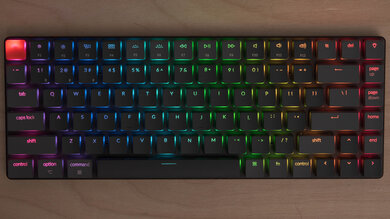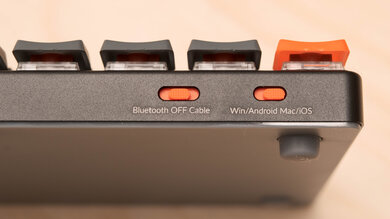The Keychron K3 is a compact 75% keyboard with function and arrow keys, and it's light enough to carry around with you. It works properly with both macOS and Windows because it has an option to switch between modes according to which operating system you're using. It's similar to the Keychron K2 (Version 2) but with low-profile switches. It's available with Gateron Low Profile or Keychron Low Profile Optical switches, and you can choose from a variety of switch types. It has full RGB backlighting, but sadly, it doesn't have dedicated software to remap any keys. Keychron suggests using third-party software, but we don't test for that. The typing quality with the Gateron Low Profile Brown switches we tested is good. Note that it may be difficult to find it at retailers, and it's best to purchase this keyboard directly from Keychron's website.
Our Verdict
The Keychron K3 is great for gaming. The Gateron Low Profile Brown switches we tested are light to press and have a short pre-travel distance. It has full RGB backlighting, but there's no dedicated software to reprogram any keys or set macros. It also doesn't offer much in terms of ergonomics, but with its low profile, you shouldn't get tired using it for long gaming sessions.
- Full RGB backlighting.
- Low pre-travel distance.
- No dedicated software to remap keys.
- Doesn't come with a wrist rest.
The Keychron K3 is amazing for use with mobile devices. It's very light to carry around, and its compact size makes it easy to place in a bag. It has great build quality, and you shouldn't worry about damaging it while on-the-go. It can connect with up to three devices at once and works with most common operating systems; only a few function keys don't work on mobile devices.
- Lightweight and compact design.
- Great build quality.
- Multi-device pairing.
- Some function keys don't work on mobile devices.
The Keychron K3 is good for office use. It offers good typing quality, and the Gateron Low Profile Brown switches on our unit are quiet, but your experience may vary depending on which switch you get. It's well-built and is fully compatible with both macOS and Windows. It has decent ergonomics, but it doesn't have any incline settings or a wrist rest.
- Great build quality.
- Good typing quality.
- Doesn't come with a wrist rest.
The Keychron K3 is good for programming. It has full RGB backlighting and the Gateron Low Profile Brown switches on our unit offer a good typing experience, but you can get it in a variety of switches. It has decent ergonomics, but it lacks a wrist rest. Sadly, it doesn't come with dedicated software to reprogram any keys, so you can't set any macros.
- Full RGB backlighting.
- Good typing quality.
- No dedicated software to remap keys.
- Doesn't come with a wrist rest.
The Keychron K3 is okay for use with a home theater PC. You can connect it wirelessly via Bluetooth, and it has full RGB backlighting, making it easier to use it while watching a movie or gaming in the dark. That said, it lacks a trackpad, which means you need a dedicated mouse to navigate the user interface.
- Full RGB backlighting.
- Connects wirelessly.
- No trackpad.
Changelog
- Updated Nov 16, 2023: We've added a link to the newly-reviewed NuPhy Air75 V2 in theLatency section of this review.
- Updated Mar 05, 2021: Converted to Test Bench 1.0.
- Updated Jan 12, 2021: Fixed an error regarding hot-swappable switches and PBT keycaps.
- Updated Jan 07, 2021: Review published.
Check Price
Differences Between Sizes And Variants
We tested the Keychron K3 Low Profile Mechanical keyboard with Gateron Brown switches and RGB backlighting. It's also available with white backlighting and you can also get it with Gateron Low Profile Blue and Red switches. There's another variant with Keychron Optical switches, which has hot-swappable switches, so you can easily replace your switches without any soldering. Your typing experience and typing noise may change depending on which switches you get.
Keychron sells extra accessories for this keyboard. You can get a wrist rest and a set of premium ABS keycaps directly from their website, so your experience may vary with these extra parts.
| Model | Backlighting | Switches | Switch Type | Hot Swappable |
|---|---|---|---|---|
| Low Profile Gateron Mechanical | RGB | Gateron Low Profile | Red, Blue, Brown | No |
| Low Profile Gateron Mechanical | White | Gateron Low Profile | Red, Blue, Brown | No |
| Low Profile Keychron Optical | RGB | Keychron Low Profile Optical | Red, Brown, Blue, White, Black, Orange | Yes |
| Low Profile Keychron Optical | White | Keychron Low Profile Optical | Red, Brown, Blue, White, Black, Orange | Yes |
If someone notices that their unit doesn't correspond to our review, please let us know in the discussions, and we'll update the review. You can see the label for our unit here.
Popular Keyboard Comparisons
The Keychron K3 is a good office keyboard and it's very similar to the Keychron K2 (Version 2), except it has low profile switches instead of regular-sized mechanical ones. Its multi-device pairing feature is a nice addition and it's compatible with most devices. However, gamers may be disappointed with the lack of macro-programmable keys and may want to look into other options, such as the Ducky One 2 SF or the Obinslab Anne Pro 2. Also see our recommendations for the best wireless keyboards, the best keyboards for Mac, and the best mechanical keyboards.
The Keychron K3 and the Keychron K2 (Version 2) are two very similar keyboards, except the K3 has low-profile switches while the K2 has normal-sized ones. The K3 has better ergonomics because its lower profile makes it comfortable to type on even without a wrist rest. It's also available in a wider range of switch types, including optical ones. However, the K2 offers better typing quality and feels better built.
The Keychron K3 and the Keychron K7 are very similar wireless keyboards, but the K3 has more keys. The K3 is a 75% board with a dedicated F-row and a Control button on its right side, which the K7 lacks because of its second Fn key. On the other hand, the K7 is a 65% board with two incline settings, unlike the K3. Both boards are available with Gateron Low Profile and Keychron Low Profile Optical switches. The K3's hot-swappable variant is compatible with Keychron Low Profile Optical switches only, while the K7 is also available with Gateron Low Profile switches.
The Keychron K3 and the NuPhy Air75 are both compact, low-profile mechanical keyboards intended for different uses. The Keychron is better suited for office use, whereas the Nuphy is better for gaming since it has better latency, and every key is macro-programmable. Also, it uses PBT keycaps rather than ABS. On the other hand, the key legends on the Keychron are shine-through, so you'll be about to see your keys in the dark. The NuPhy is hot-swappable, and the Keychron also comes in a hot-swappable variant, so you can change out the stock switches without soldering.
The Keychron K6 and the Keychron K3 are both very good all-around keyboards with similar features. The main difference is in their designs. The K6 is a compact 65% keyboard with standard keycaps while the K3 is compact 75%, meaning it has a function row, and it has low profile switches. They're each available with clicky, tactile, and linear switches. Typing feels better overall on the K6, but some people may prefer the low profile switches instead. Latency is also lower on the K6.
Test Results

The Keychron K3 is a compact 75% keyboard that has function and arrow keys. It's much lighter than the Keychron K2 (Version 2) and shouldn't be too big to carry around. If you're interested in a similar option but without function keys and with high-profile keycaps, check out the Keychron K14.
Update 01/12/2021: We previously said that you can buy extra PBT keycaps on Keychron's website. Even though you can buy an extra set, they're premium ABS and not PBT. The review has been updated.
The Keychron K3 has great build quality. Its frame is aluminum while there's plastic underneath. It flexes a bit when you press down hard on a key, but this shouldn't be much of a problem during normal use. The keys slightly wobble, but it's not too noticeable while typing. The ABS keycaps feel like they can easily develop shine from oil over time. There aren't any loose parts, and the larger keys don't rattle. There are four rubber feet underneath, and the keyboard doesn't slide around on the desk.
The Keychron K3 is a simple, low profile keyboard with decent ergonomics. It doesn't have any incline settings. However, you can remove the top feet and use the stick-on replacement feet instead, which creates a lower incline, but you won't be able to switch between each set of feet easily. It doesn't come with a wrist rest, either, and since it has such a low profile, you may not need it. Still, if you prefer a wrist rest, Keychron sells a wooden one separately. For a more compact low-profile keyboard with incline settings, check out the Keychron K7, or check out the updated version of this board, the Keychron K3 (Version 2), which has two incline settings added.
The Keychron K3 has full RGB backlighting with individually-lit keys. You can cycle through brightness settings and lighting effects using the Fn and function keys. It doesn't get bright enough to make the colors stand out in a well-lit room.
The Keychron K3 comes with a braided USB-C cable that retains kinks from the packaging. You can easily replace it in case it damages. The keyboard connector noticeably wobbles in the port, which is something we noticed with the Keychron K1 as well.
The Keychron K3 can connect with up to three devices at once via Bluetooth, or you can use it wired while charging. The battery is advertised to last up to 34 hours with RGB on, but this isn't something we test for.
The Keychron K3 doesn't have many extra features. There's no proprietary software to reprogram any buttons, and even though Keychron recommends third-party software, this isn't something we test for. There are switches on top to change between the Windows/Android or mac/iOS modes. Note that there's a variant with hot-swappable switches, so you can easily replace and change your switches without any soldering, but ours doesn't have this feature.
Our unit of the Keychron K3 uses Gateron Low Profile Brown switches, which provide a tactile feel. They have a low pre-travel distance and don't require much force to press. You can also get it with clicky Gateron Low Profile Blue or linear Red switches, such as the ones we tested with the Keychron K1. The keyboard is also available with Keychron Low Profile Optical switches, and that variant has hot-swappable switches, so you can easily change them without soldering.
Update 01/12/2021: We previously said that you can buy extra PBT keycaps on Keychron's website. Even though you can buy an extra set, they're premium ABS and not PBT. The review has been updated.
The Gateron Low Profile Brown switches on our unit of the Keychron K3 provide nice tactile feedback and good typing quality, but your typing experience may change depending on which switches you get. The keys wobble a bit, but it isn't very noticeable during normal use. The layout feels cramped, and you may notice an increase in typos if you're not used to it. The right Shift is also smaller than the left Shift, so you may accidentally hit the arrow keys instead. Also, the ABS keycaps feel slippery. Overall, it shouldn't feel tiring typing on it for long periods, and it's an improvement over the Keychron K1.
Some people may not be a fan of the low profile keys, so if you prefer a compact keyboard with standard keys, then look into the ROYAL KLUDGE RK61.
Our unit of the Keychron K3 with the Gateron Low Profile Brown switches is quiet, but your experience may vary depending on which switch you get.
The latency of the Keychron K3 is a bit high, whether you use it wired or via Bluetooth. It should still be okay for regular, everyday use. However, it might disappoint gamers looking for the lowest input lag. If you're interested in a similar wireless, low-profile model but with better gaming performance, check out the NuPhy AIr75 V2.
The Keychron K3 doesn't come with dedicated software to customize the RGB lighting or reprogram keys. However, Keychron recommends using third-party software to remap keys. In the manual, they recommend Karabiner for macOS and SharpKeys for Windows, but we don't test for these programs.
The Keychron K3 is fully compatible with both Windows and macOS, as long as you set the keyboard to the proper mode with the switch on the top side. The F3 and F4 keys don't work on iOS or iPadOS. You should set the OS slider to 'mac/iOS' if you're using it with Linux, but the F3 and F4 hotkeys don't work. If you set the keyboard to the 'Windows' mode on Linux all of the function keys and the F3 and F4 hotkeys don't work.









